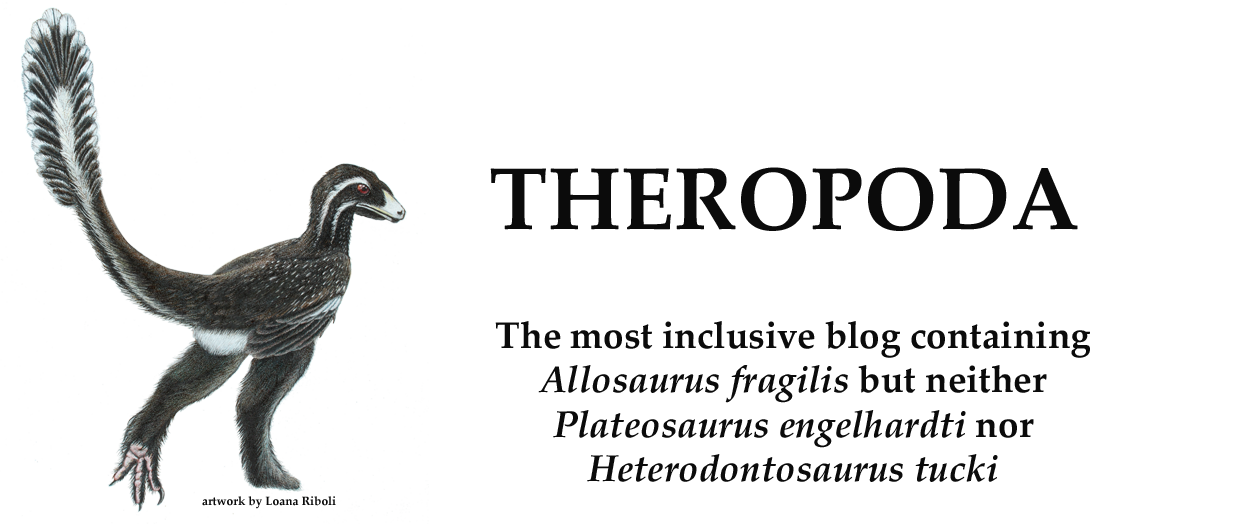NOTA BENE: QUESTO POST NON HA PRETESE DI ESSERE UN'ARTICOLO SCIENTIFICO, MA E' SOLO UNA MIA SUGGESTIONE DERIVANTE DA UN'ANALISI FILOGENETICA NON PUBBLICATA. Pertanto, nessuno è autorizzato a citarla come ipotesi scientifica, che non è, dato che è solamente un post in un blog.
Alla luce delle numerose novità tyrannosauroidi del 2009, ecco il risultato più recente di Megamatrice, dopo la ri-codifica di Proceratosaurus.
 La posizione e l'età di Proceratosaurus implicano una grande radiazione tyrannosauroide nel Giurassico Medio, che generò almeno quattro linee:
La posizione e l'età di Proceratosaurus implicano una grande radiazione tyrannosauroide nel Giurassico Medio, che generò almeno quattro linee:
Coeluridae: clade molto basale, e difatti morfologicamente molto simile agli altri Coelurosauria basali di grado "compsognathoide". (Giurassico Medio-Superiore).
"Stokesosauridae": la prima radiazione di grandi tyrannosauroidi. (Giurassico Medio-Berremiano).
Proceratosauridae: Clade di tyrannosauroidi crestati di taglia medio-piccola. (Giurassico Medio-Barremiano).
"Neotyrannosauria" ("tyrannosauroidi derivati"). (Giurassico Medio-Fine del Cretacico). Interessante notare che questo clade è per ora l'unico ad avere forme nel Cretacico "medio" e Superiore, e che, attualmente, non è noto da fossili giurassici.
Questo dato parrebbe mostrare un evento di estinzione tra i tyrannosauroidi, avvenuto nel Cretacico Inferiore, che avrebbe eliminato Stokesosauridi e Proceratosauridi, permettendo la radiazione adattativa dei Neotyrannosauria.
Avvertenza: All'interno di Neotyrannosauria abbiamo un clade, "Alioramidae", che potrebbe essere "spurio", derivante dall'inclusione nell'analisi di taxa codificati su esemplari non adulti, ovvero, stadi ontogenetici immaturi che presentano un mix di caratteri tipici delle forme filogeneticamente più basali.
Suggestione? Pazzia prematura ed immotivata?
Post Scriptum: Attendo con ansia le analisi filogenetiche di Tyrannosauroidea in preparazione, così da aggiornare i dati da cui deriva l'analisi mostrata qui ;-)
Alla luce delle numerose novità tyrannosauroidi del 2009, ecco il risultato più recente di Megamatrice, dopo la ri-codifica di Proceratosaurus.
Ammettiamo per un attimo che questo risultato persista, esso ha le seguenti conseguenze:
 La posizione e l'età di Proceratosaurus implicano una grande radiazione tyrannosauroide nel Giurassico Medio, che generò almeno quattro linee:
La posizione e l'età di Proceratosaurus implicano una grande radiazione tyrannosauroide nel Giurassico Medio, che generò almeno quattro linee:Coeluridae: clade molto basale, e difatti morfologicamente molto simile agli altri Coelurosauria basali di grado "compsognathoide". (Giurassico Medio-Superiore).
"Stokesosauridae": la prima radiazione di grandi tyrannosauroidi. (Giurassico Medio-Berremiano).
Proceratosauridae: Clade di tyrannosauroidi crestati di taglia medio-piccola. (Giurassico Medio-Barremiano).
"Neotyrannosauria" ("tyrannosauroidi derivati"). (Giurassico Medio-Fine del Cretacico). Interessante notare che questo clade è per ora l'unico ad avere forme nel Cretacico "medio" e Superiore, e che, attualmente, non è noto da fossili giurassici.
Questo dato parrebbe mostrare un evento di estinzione tra i tyrannosauroidi, avvenuto nel Cretacico Inferiore, che avrebbe eliminato Stokesosauridi e Proceratosauridi, permettendo la radiazione adattativa dei Neotyrannosauria.
Avvertenza: All'interno di Neotyrannosauria abbiamo un clade, "Alioramidae", che potrebbe essere "spurio", derivante dall'inclusione nell'analisi di taxa codificati su esemplari non adulti, ovvero, stadi ontogenetici immaturi che presentano un mix di caratteri tipici delle forme filogeneticamente più basali.
Suggestione? Pazzia prematura ed immotivata?
Post Scriptum: Attendo con ansia le analisi filogenetiche di Tyrannosauroidea in preparazione, così da aggiornare i dati da cui deriva l'analisi mostrata qui ;-)

Did you pretend the taxa known only from young specimens (e.g. Alioramus, Raptorex) were adults, or did you code them as unknown for characters that change during growth in other tyrannosauroids?
RispondiEliminaI code them as unknown for characters changing during growth... but the main problem is: how many characters are ontogeny-related? I follow these assumption:
RispondiElimina-Proportions among skull and limb elements are coded as "unknown" if they clearly change during growth in modern archosaurs.
-Fusion of elements.
-Crests/rugosities/ornamentations.
But, sometimes, it is difficult to say if a character is ontogeny-related...
For example, one of the "alioramids" apomorphies would be the presence of a relatively short external naris (a reversion to the pre-tyrannosauroid status). I though only a long external naris should be ontogeny-related (being linked to snout elongation during maturation), and a short one should be a "true character".
Is this character ontogeny-related? In modern archosaurs, the elongation of the snout in adults produce a relatively shorter naris, so, subadult taxa having short naris should show the "true adult condition".
Is it true also for tyrannosauroids, where most taxa are long-snouted, and a short skull could be a derived condition?
"_Nanotyrannus_" naris is relatively shorter than adult tyrannosaurids, so I suspect it's a ontogeny-related character AMONG tyrannosauroids. So, I should code it as unknown in "alioramids" only if I assume "a priori" that they are tyrannosauroids... but this is what the analysis has to test, and cannot be assumed before doing the analysis.
"Alioramid" unanmbiguos apomorphies:
1-External naris no more than 60% antorbital fenestra length.
2-Short cervical neural spines.
3-Pneumatic recess at base of maxillary ascending ramus.
4-Maxilla interfenestral bar narrow.
5-Ventral margin of antorbital fossa decrease in depth caudally.
6-Nasal "D-shaped" in section, nor merely convex.
Are most of them ontogeny-related? I suspect at-least some of them could be. In future tests, I would code them as unknown in Alioramus and Raptorex... ;-)
Molto interessante ma quali son le analisi che supportan i celuridi dentro i tirannosauroidi, per fav?
RispondiEliminaSenter, 2007: A new Phylogeny of Coelurosauria (Journal of Syst. Paleo.). L'analisi colloca un nodo "Tanycolagreus + Coelurus" alla base di Tyrannosauroidea.
RispondiEliminaMe lo potresti inviare (se ce l'hai, ovvio^^), per fav?
RispondiEliminabrisio333@libero.it